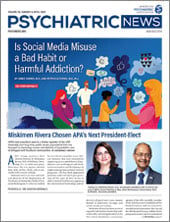The differing degrees of acculturation and assimilation among the Hispanic/Latinx population of the United States are important factors in the risk of substance use initiation and developing a substance use disorder (SUD), said panelists in a February webinar titled “Addressing Alcohol & Substance Use Disorder in the Hispanic Community: Unpacking Sociocultural Risk and Resilience.” The webinar was moderated by Héctor Colón-Rivera, M.D., M.B.A., M.R.O., president of the APA Hispanic Caucus, as part of APA’s Looking Beyond Series. This series explores ways of improving mental health in historically marginalized and minoritized communities.
“We’re talking about so much diversity not only in country of origin but also immigration history,” said Caridad Ponce Martinez, M.D., an assistant professor of psychiatry and the director of the addiction psychiatry fellowship program at the University of Massachusetts Medical School. She explained that youth who were born in another country and moved to the U.S. during a transitional age with their families may still be immersed in the practices from their countries of origin that guide substance use and initiation, whereas youth who were born in the U.S. to parents who are immigrants may try to behave more like their peers.
Karina Aguila, Dr.Ph., M.S.W., an assistant regional director at the Substance Abuse and Mental Health Services Administration, agreed.
“As a young person coming in, you’re navigating by cultural identity, and incorporating aspects both from your [native] culture but also from the U.S. culture and the different [experiences] of what’s going on in school,” she said. “All of those things impact the possibility of the initiation to substance use.”
Martinez said that adults in the Hispanic/Latinx community face a different set of challenges. She explained that because a stable income is often crucial to their survival and the survival of their families, anything that could take them away from their ability to work, such as inpatient treatment for SUD, takes a back seat to putting food on the table.
“They might be viewing substance use as less problematic as long as they’re able to maintain employment,” Martinez said. She added that people in the Hispanic/Latinx communities often do not have a backup system or support should they need time off from work, resulting in a loss of family income.
Fabiola Arbelo Cruz, M.D., an assistant professor of psychiatry at Yale School of Medicine, said that health professionals need to avoid assuming that ethnic identity as a social classification equates to increased drinking and substance use, however.
“It is important to understand how [identifying as Hispanic or Latinx] translates to risk factors versus how racial and ethnic inequities in access to housing, medical care, or even spiritual discrimination contribute to [substance use] initiation,” Cruz said.
Aguila spoke of the complex, systemic barriers to care that members of Hispanic/Latinx communities often face. These include the following:
•
Social, economic, cultural, and policy factors that contribute to treatment disparities.
•
Language barriers and the limited availability of treatment programs in Spanish.
•
A lack of bilingual and culturally competent health professionals and educational materials.
•
Cultural stigma that affects an individual’s ability and willingness to seek mental health and substance use treatment.
•
Religious or traditional beliefs that may discourage individuals from disclosing certain things to people outside of their family or home.
•
Limited financial resources to afford treatment.
Cruz added that mental illnesses such as depression and anxiety are independently linked to substance use and that people in the Hispanic/Latinx population are at greater risk of these illnesses because of discrimination and disparities related to social determinants of health. To that end, it’s crucial that each community has health professionals who belong to the community.
“[P]eople who share the racial and ethnic heritage of the community, the language, the socioeconomic status, the life experiences [are often] more effective for ... our underserved communities. They are found to be more accessible than traditional clinical behavioral health services and workers,” she said.
“Treatment does not happen in isolation and ideally should not happen in a single instance of care but [rather through] developing a relationship with communities and with individuals.” ■


